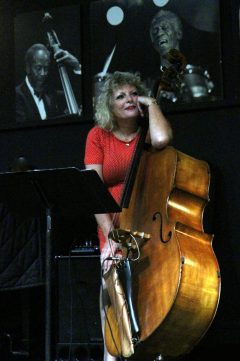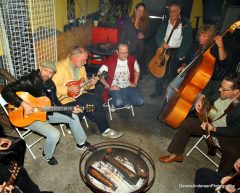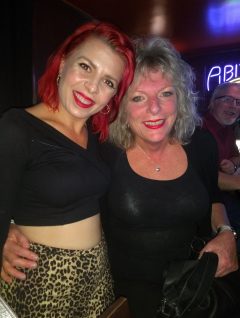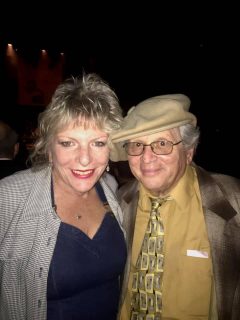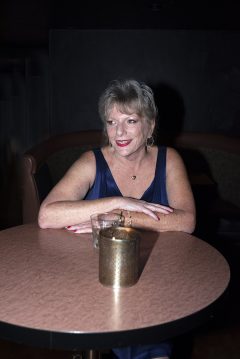Cover Story
Jodie Hill: At the Top of her Game
“‘If you want to be a successful musician, you’ve got to be versatile.’ That’s what one of my teachers told me.” Jodie Hill was not yet in high school, but she clearly remembers this musical career advice. And if her schedule is any indication, she has taken that advice and applied it every day of her life.
For the last ten years, Hill has established herself as one of the first-call bass players in San Diego. One night might find her performing big band music with the Jazz Katz Project, the next night she might be performing Django Reinhardt-inspired Gypsy jazz with the Gypsy Swing Katz. She performs regularly with San Diego’s state-of-the-art bluesman Robin Henkel and his horn band. Hill is involved in the King Taylor Project, a rock/R&B-based ensemble. “And I was also playing in three big bands,” Hill says. “But that got to be too much.”
Hill has performed with San Diego premier vocalist Whitney Shay for the last nine years. At first, the band configuration was Whitney Shay and the Shakedowns, performing mostly rhythm and blues. But then Shay started getting gigs at such places as the U.S. Grant, and so the repertoire switched to mostly jazz. Lately, Shay has had a renewed emphasis on blues and R&B. There will be more about this later.
This past July, Hill was part of the world premier production of One More Roll of the Dice. “What they did was take a lot of the tunes that had been cut from Guys and Dolls and created a story around that,” says Hill. The Frank Loesser musical, written by Mark Saltzman and based on the characters of Damon Runyon, enjoyed a five-week run at the North Coast Repertory Theatre in Solana Beach. “I’ve done other musicals, but I think that this is going to be my last,” says Hill. “It locks you into the same thing every night.”
Hill performed with Gunhild Carling when the YouTube star and Swedish traditional jazz sensation performed in southern California. Among Hill’s recent recordings are studio sessions with 22 Kings and the most recent release from Robin Henkle and his horn band. Hill has recorded and appears in videos, which are a bit like rock operas. Sluka Introversions was released in 2016. And Colorful Radiation came out in 2017.
Hill receives not only phone calls from bandleaders but she receives their accolades as well. She is appreciated for her ability to read through charts, something bass players and guitar players can be slow on the uptake on that learning curve. She is admired for her professional demeanor.
Besides musicianship and working hard at her gig, Hill has a rare gift that benefits her as a musician. She has a near perfect memory. She only needs to read through or play a tune once for her to have it memorized. Another asset, Hill performs both on the upright bass and electric bass. She gets the calls for the gigs that require an upright, while the electric players in town sit around and claim that they are getting around to taking up the acoustic version of their instrument. Switching between the two instruments is not like going from acoustic guitar to electric guitar. The angle and relationship of the instrument to the player are different—the fingerings differ, and the big thing that intimidates players of electric bass, the upright has no frets. OMG!
Speaking of no frets and electric basses, Hill’s favorite instrument is her fretless electric bass, the type of electric bass played by Jaco Pastorius that lent him his signature sound. Her love of the instrument has less to do with the watery sounds and slides the instrument can produce and more with practicality and performing in New York City for 30 years. “In New York you’re always on the metro or the subway, and it’s impossible to get your upright anywhere without getting it dinged up,” she says. “The people I worked for wanted that upright sound, so in 1984 I got the fretless that I still have.”
On a recent Thursday night I made it down to the Gaslamp, District to hear Hill perform with Whitney Shay. A warm November night, the Gaslamp was lively enough but was not crunch-crowd crazy like on the weekends. The scene was as it has been for the last 30 years. Groups of girlfriends clipped along in their short skirts and towering heels, and the menu evangelists hawked their wares at the entrances of the overpriced restaurants. I ducked down into a basement, which seemed like a portal passing under the Berlin Wall to enter a nightclub.
Considering that it is a fixed up basement, the place is pretty nice. Along one wall of the bar are booths with backs that extend to the ceiling. Everything about the booths is so oversized that they Lilliputianate the people sitting there. The ceiling is black and scattered with playing cards, as though this were the aftermath of an IED hitting a gin rummy tournament.
I grab a red sangria and take a seat under the seven of clubs and nine of diamonds. Dressed in a red patterned jumpsuit and center stage is Hill with a five-string electric bass and a mint, totally mint Kustom amplifier. Yes, the kind with the pleated and tucked Naugahyde covers, the really great ones from the seventies. It looks like it just came from the showroom.
From the first downbeat of the first tune, the band is tight, I mean really tight. Drummer Tony Econom and Hill lock, while guitarist Joe Amato skates on top of it all. Amato’s playing is solid yet has a fluidity that is, well, just dynamite. Shay sings. She borrows a lot from the soul singers of the sixties and seventies, yet has a style that is all her own. Unusual for an R&B, Hill takes a solo on the second tune. For most of the first set a smartly dressed couple takes to the dance floor and show the room what great dancing looks like. On a break Hill talks about the band. “We’ve been together a while, and it’s given us a chance to get really tight,” she says.
Hill grew up in Columbus, Ohio and experienced all that a Midwesterner would experience in that part of the country during midcentury. As a child, her choice of the bass was pretty straightforward. “I saw the Beatles on the Ed Sullivan Show, fell in love with Paul, and it was the bass from thereon after,” she says. While she was still in school, she took up the trombone and even played the instrument into adulthood.
Besides the influence of the Beatles, Hill grew up in a musical home. Her father was a drummer, and her mother played the piano. Hill’s father was also a big jazz fan and audiophile. “Dad was that typical unemotional sort,” she says. “So a lot of the time I spent bonding with him were times of just kicking back and listening to music.”
Hill worked cleaning mobile homes and saved up enough money to buy an electric bass and amplifier. “I had a Hangstrom bass and a Supro amplifier,” she says. “The amp was so big and heavy that my dad would have to help me getting it to gigs!” A typical musical enthusiast, she hung out at the local music store, where she found a used upright bass that she was able to buy for $500. Painted completely black, Hill removed the paint to find a very good quality German made bass. The bass remained her main instrument for decades until she replaced it with a high quality bass, one that was custom made for her.
After a couple years on the road with a rock band or two, Hill attended Berklee College of Music in Boston. “I auditioned after high school, but money was a problem. My dad came to me and said that they didn’t have the money for the tuition,” she says. “I got a job in a factory and paid my own tuition.” The private music college in Boston, the largest independent college whose emphasis is on rock, jazz, and other popular music in the world, boasts a roster of famous and talented performers, composers, and arrangers. Among the alumni that share the distinction of Berklee with Hill are bassist and singer Esperanza Spaulding, jazz pianist Cyrus Chestnut, and the man who has been the master of popular American music over the last five decades: Quincy Jones.
Although she performs on both the electric bass and upright bass, Hill studied only the upright at Berklee. “This was right at the point when electric guitar was really taking off and electric bass, too. And they weren’t prepared for that. Berklee didn’t know what to do with the electric instruments. At that point they were geared toward teaching jazz, so that’s the upright bass,” she says. Hill studied with Major Holley, the venerated jazz bassist who performed with jazz greats such as Dexter Gordon, Charlie Parker, and Ella Fitzgerald. “At my first lesson I walked in with my electric bass, and he said, ‘I’m not teaching that.’” Meanwhile, she was keeping her chops up on the electric bass, as all of Hill’s gigs around the Boston area were on the electric. Hill spent three years studying at Berklee, with circumstances getting in the way of her graduating with a degree. “But I got all the knowledge that I needed to be a professional musician,” she says.
After her time in Boston and attending Berklee, musician colleagues from Ohio convinced Hill to make her way to Indianapolis. There, Hill established her career around making jingles, those short catchy tunes used in commercials. The whole model for making a jingle is to get the musicians into the studio and record the jingle as quickly as possible. For the producers of jingles, they only want the most talented professional musicians, and Hill was a shoo in for this business model. “I worked for three jingle companies while I was there,” Hill says. If you’ve been around for a while, you’ve probably heard Jodie Hill on your radio. “Most of what I recorded was for local markets, but some of what I worked on was for national markets, too,” she says.
While she was in Indiana, Hill also recorded for a record company that produced contemporary gospel music. “And it’s also a great music scene there,” Hill says. “There were a lot of great players coming out of Indiana University School of Music.”
A jingle producer convinced Hill that there were great work opportunities recording jingles in New York City. “The people doing the production there, they liked the way I played. I could lay down something in one or two takes, and you know with music studios time is money.” She averaged around four jingles a week making $100 per jingle, the equivalent of around $300 in 2019 dollars. “But New York is also a place where the competition for those kind of gigs was unbelievable,” she adds. Hill found a great deal of work in weddings, playing more than 125 nuptials a year. “Sometimes I would play five weddings in a weekend,” she says. “I got so busy I had to hire a guy to lug my gear around.”
Remember growing up and watching the late show? Chiller Theatre? Elvira? All that weekend scary stuff with features such as Attack of the Mushroom People and Teenagers From Outer Space? During the movie, just when the space probe had made it to the planet Algathoron, there would be a commercial from K-Tel, selling an album of 41 of your favorite hits. Kenny Loggins! KC and the Sunshine Band! The McCoys! The only thing was that the K-Tel albums were not of the original performers, but recorded by K-Tel to be the equivalent of their musical clones.
Hill worked on some of those recordings. “I did 24 songs for K-Tel,” she says. “They would send you a list of the songs they wanted you to do. You’d go buy the 45s. [Note to young people: 45 refers to 45 RPM, a vinyl disk on which two songs (one on each side) are played on a turntable.] And you would learn the song, note for note.” Hill describes the maddening process of rendering an almost perfect copy of the major hit. “Then in the studio, one side of your headphones would be the original recording and the other would be the studio. And you would work to get it exact as the original.”
It might be time, dear reader, if you’re still with us, to explain a bit about Hill’s instrument, the bass. It is an instrument that is very common yet in many ways obscure. With a band, we all know that we hear the guitar and piano and people singing, but if you asked most folks if they heard the bass, they might look at you dumbfounded. If, during a performance, the bass were to drop out, stop playing, however, everyone would most certainly notice.
So, yes, the bass is there. Next time you hear a band, make sure to listen for it. People sense its presence. It is the beat of the bass that people dance to, not the drums, as is commonly believed. It is the foundation of the band. Because it controls the rhythm and chordal foundation of a band, the bass is considered the most important instrument in a jazz ensemble.
This bass blindness has changed in the 40 years. Jaco Pastorius, in the seventies, progressed the bass from an instrument of support to other instruments into a voice within the ensemble. Along came bands like Morphine, which featured a prominent electric bass. And then there is the Red Hot Chili Peppers’ Flea, who makes the bass impossible to ignore.
And then again there is sexism in popular music. For the most part, in rock and jazz, women have been thought of primarily as singers, not players. As to encountering sexism, Hill says that things are much better than when she was playing in the seventies and eighties. “But there were times I’m sure I didn’t get the gig because I was a gal,” she says.
Hill has made her home in San Diego for the last ten years, and, as detailed above, has had a great deal of success. One might think that it would be something of a comedown to change music scenes from New York to San Diego. After all, what comes to mind when most folks think of New York is its music scene. There is the Blue Note, the Birdland jazz club, and those listings of jazz performances in the New Yorker. With places like Dizzy’s, Panama 66, and some other night spots with great musical lineups, Hill sees the music scene in San Diego as being in some respects better than that of New York. “There are a lot of places to play here. The big places in New York are only interested in you if you’re famous,” she says.
I met Jodie Hill not long after she moved to San Diego. For me, I had been writing for this publication for six years, long enough to score me a secure invitation to the Troubadour’s annual Christmas party. The 2009 Christmas party was held on a night of bone chilling frigid temperatures, which for San Diego means that thermometers were hovering around the low 60s. And that’s Fahrenheit, not Kelvin. As the Troubadour is about local music, in addition to us renowned music journalists, the party was populated by lots and lots of musicians. And when you have lots and lots of musicians, you get jam sessions.
Despite the frigid temperatures, a jam session broke out outside. Gathered round a fire pit on the lawn were a bunch of guitar players. They were in need of a bass player, so I offered my services. (Note: I usually try to keep my musical experiences separate from my journalistic work, but in full disclosure, I play the string bass.) As the cold seeped into my joints, and I wanted to avoid frostbite, I decided to head into he warmth of the house. Hill, perhaps still used to the even more frigid New York winters, wearing only a light cream-colored sweater, took over.
Later that night I got a chance to talk to Hill, and we bonded over our love of music and the bass. Hearing her earlier, it was clear that she was a top-notch musician; so I was pretty sure that Hill would prove to be a success in our town. But in talking to her that night, I was impressed with her determination to work, and I still remember what she said that convinced me that she would definitely succeed here. “If a gig comes your way, take it,” she said. “Never turn down anything.”






